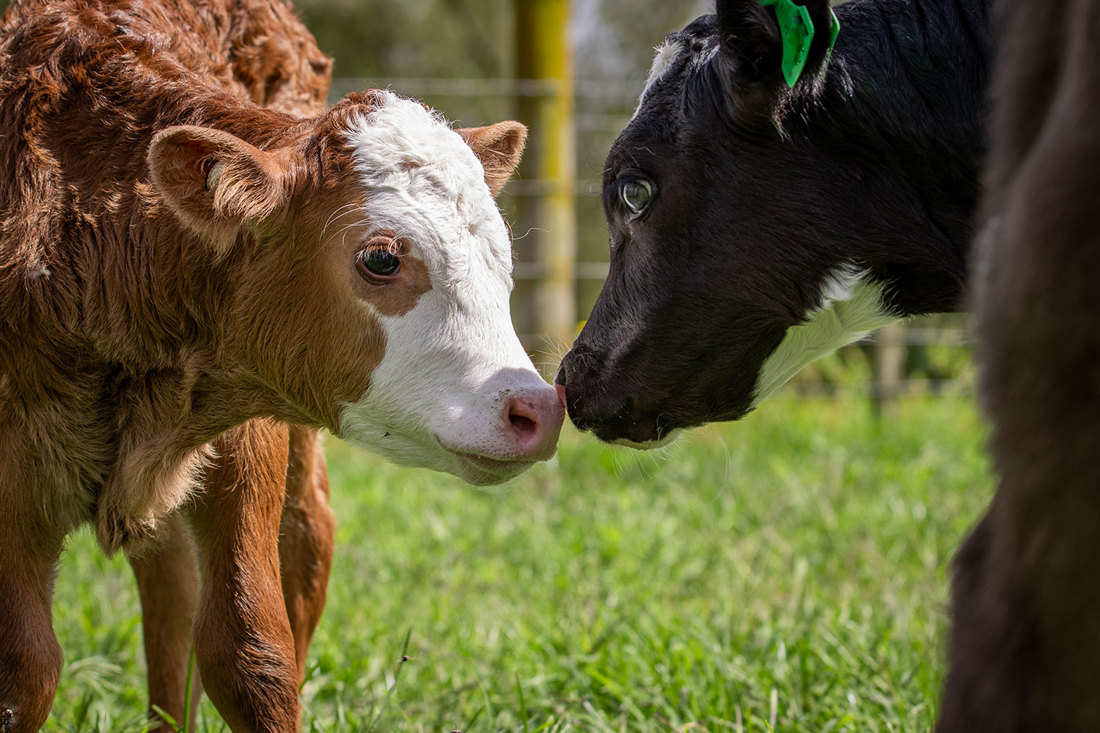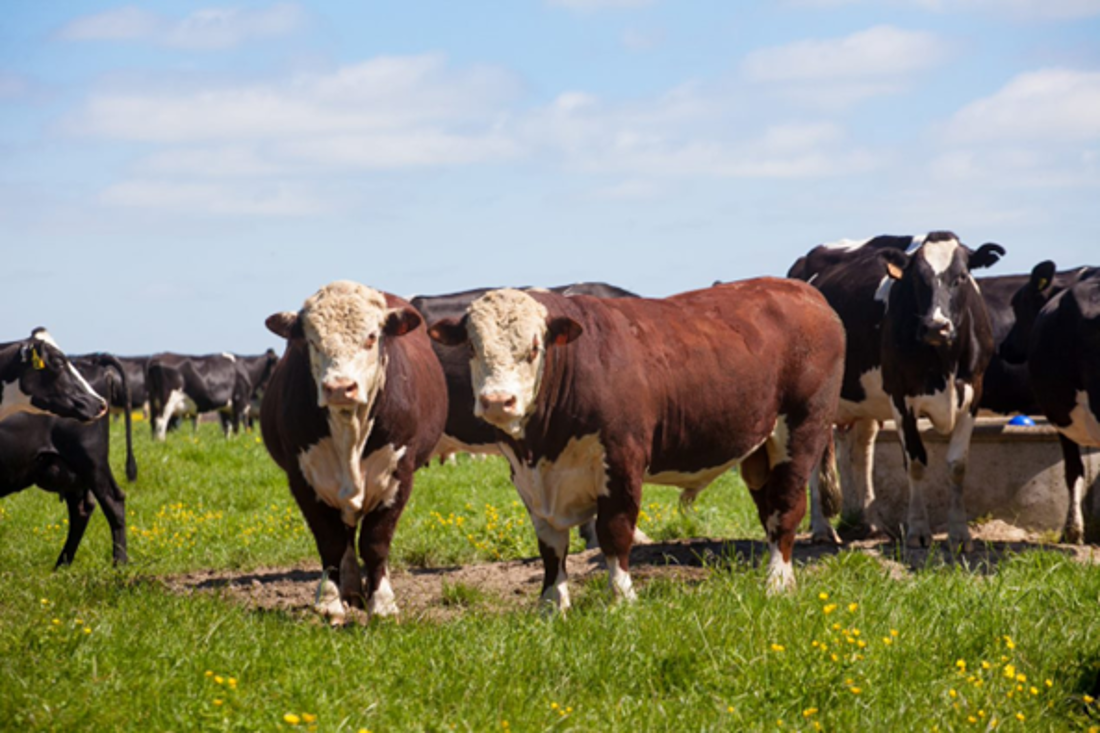Dairy beef
8 min read
Dairy-beef animals are those animals born in the dairy industry and sold for beef production. Beef-on-dairy animals are animals sired by beef and born to dairy dams and are either raised or sold for beef production. When selecting beef-breed sires for beef production, consider traits such as gestation length, birthweight, growth rates, and beef characteristics. Additionally, within-breed sire variation exists, affecting selected traits. Read more below on how to select and rear successful dairy-beef calves for beef production.
Dairy-beef cattle include those animals born to dairy dams, even if the calf has no beef-breed genetics, for example, Friesian bull calves and cull cows. These animals are usually born on a dairy farm and are reared or sold for beef production. Beef-on-dairy animals are typically progeny born to dairy animals and sired by beef, for example, Friesian-Hereford cross calves. They are sometimes referred to as beef-on-dairy animals or beef-cross animals and fall under the category dairy-beef animals.
Seventy two percent of dairy farmers already use beef genetics to improve the value and performance of calves that are surplus to requirements for their dairy business (Edwards et al, 2021). The successful production of dairy-beef requires both the beef and dairy industries to work together to increase profitability and efficiency.
Dairy farmers incur beef levies of $5.20 per head at slaughter for cull dairy cows. The same levy applies to cull dairy heifers and bulls, but bobby calves are exempt from levies. This levy goes towards research and development, market access, and government negotiation, advocacy and promotion of New Zealand beef products. Read more about Beef + Lamb New Zealand levies on dairy-beef animals.
There are some opportunities in which dairy-beef can be beneficial:

A wider range of beef breeds are available from most breeding companies, for example, Wagyu, Charolais, and Stabiliser, as well as more traditional breeds such as Angus and Hereford. Selecting sires that have desirable traits such as high-growth rate to 400 days, gestation length, and calving ease are critical when mating a percentage of the herd for beef production.
Select sires based on performance for the following beef and dairy characteristics:
Beef + Lamb New Zealand are progeny testing the performance of bulls with estimated breeding values (EBV's) that indicate they are likely to be excellent bulls for beef-on-dairy farm systems.
Read more on the Beef + Lamb New Zealand performance of bulls here.
Different bull breeds have general trends in genetic production and efficiency characteristics, but there are within-breed sire differences. That is, one bull of the same breed will perform differently to another bull of the same breed. This difference might result in varying gestation lengths, birth weights, or carcass characteristics and growth rates. The sire selection is more important than the breed selection.

Gestation length varies significantly based on factors such as heritability, sire genetics, breed, and calf gender. Beef breeds typically have longer gestation periods compared to dairy breeds.
In New Zealand, the average gestation length of dairy cattle is 282 days, but there is genetic variation around this. You should be aware of the gestation length Breeding Values of the beef sires you are using as it will affect the calving date of your cows.
Short gestation length can reduce the overall duration by 8-10 days. In most cases, when using short-gestation-length beef-bred semen, the gestation length can be similar to that of conventional dairy-bred semen. Although this is not the case for all breeds, for example, the Wagyu beef breed.
It’s essential to consider sire variation within the same breed for birthweights and gestation length traits. Proven beef sires may have shorter gestation lengths than the average for dairy; for example, Angus bulls in the top ten percent for gestation length estimated Breeding Value produce progeny with an average gestation length of 279 days.
If you’re exploring new semen technologies, start on a small scale to gain experience before committing fully, and consult your breeding company for insights into the expected results from different semen types.
It is important to select beef-bred sires for lighter birth weights to minimise calving difficulty while ensuring calves have great growth rates. Using proven sires allows you to select beef-bred sires to produce progeny with lighter birth weights and in some cases still achieve high growth rates. The dam’s genetics will also influence birthweight.
Birth weight significantly impacts calving ease, especially among younger and smaller dairy cattle. Calving difficulties increase by 2.3 percent per kilogram increase in birth weight. The rule of thumb is that beef breeds have greater birth weights than lighter dairy breeds (e.g. Jersey), but this doesn’t hold true for all breeds (e.g. Angus). Proven sires through progeny testing ensure lower birth weights and avoid risk of within breed variation.
Dairy farmers aiming to select beef breeds for semen should select proven sires to ensure that subsequent calves have comparable birth weights to those of dairy breeds. From a beef rearing perspective, the minimum birth weight required for beef rearing is recommended at 35 kg to ensure calves reach target liveweights (Coleman et al, 2022).
There are currently progeny proven sire beef genetics available on the market.
Heritable traits related to cattle carcass characteristics and growth rates can be enhanced through crossbreeding strategies, leading to improved retail profitability in dairy breeds due to beef heterosis.
Carcass characteristics include dressing out percentage, eye muscle area, lean meat yield, muscle to bone ratio, subcutaneous fat, and marbling (intramuscular fat).
Dairy progenies: Lighter carcass weight, low muscle to bone ratio due to poor muscularity, lower dressing out percentage, and smaller eye muscle area (indicative of lower lean muscle yield). Dairy breeds have the least subcutaneous fat resulting in below-average grading at slaughter.
Beef progenies: Heavier carcass weights, greater lean muscle yield, muscle to bone ratio, and dressing out percentage compared to dairy and beef-on-dairy animals. Beef breeds exhibit superior subcutaneous fat depths Even smaller-framed beef breeds (e.g. Angus) produce more muscle relative to frame size than dairy breeds.
Dairy calves sired by beef (beef-on-dairy animals): Lighter carcass weights, low muscle to bone ratio, and lower dressing out percentage compared to beef breeds. Due to increased muscularity, they exhibit greater dressing out percentage, muscle to bone ratio, eye muscle area, and lean meat yield at slaughter when compared to dairy breeds. Beef genetics positively influence carcass characteristics.
There is opportunity for utilising different breeding strategies to break into the dairy-beef market. Strategic selection of high-genetic-merit beef-bred sires is critical for maximising beef genetics in mating programs. However, there are some limitations around how this market can be grown, and any growth needs to be done in a profitable and stable way to ensure the value of beef-on-dairy is kept or improved. Before deciding to rear more beef-on-dairy animals, build connections with your selected beef rearers, and select beef traits suitable for both your farm system needs.
Now’s the perfect time to check in, plan, and set up for a strong season. We’ve pulled together smart tips and tools to help you stay ahead all winter long.
Whether you prefer to read, listen, or download handy guides, we’ve got you covered with trusted tools to support your journey every step of the way.
Put our proven strategies and seasonal tools to work. Boost production, support animal health and watch your profits hum.
Tools that are backed by science, shaped by farmers and made for this season.
That’s Summer Smarts.